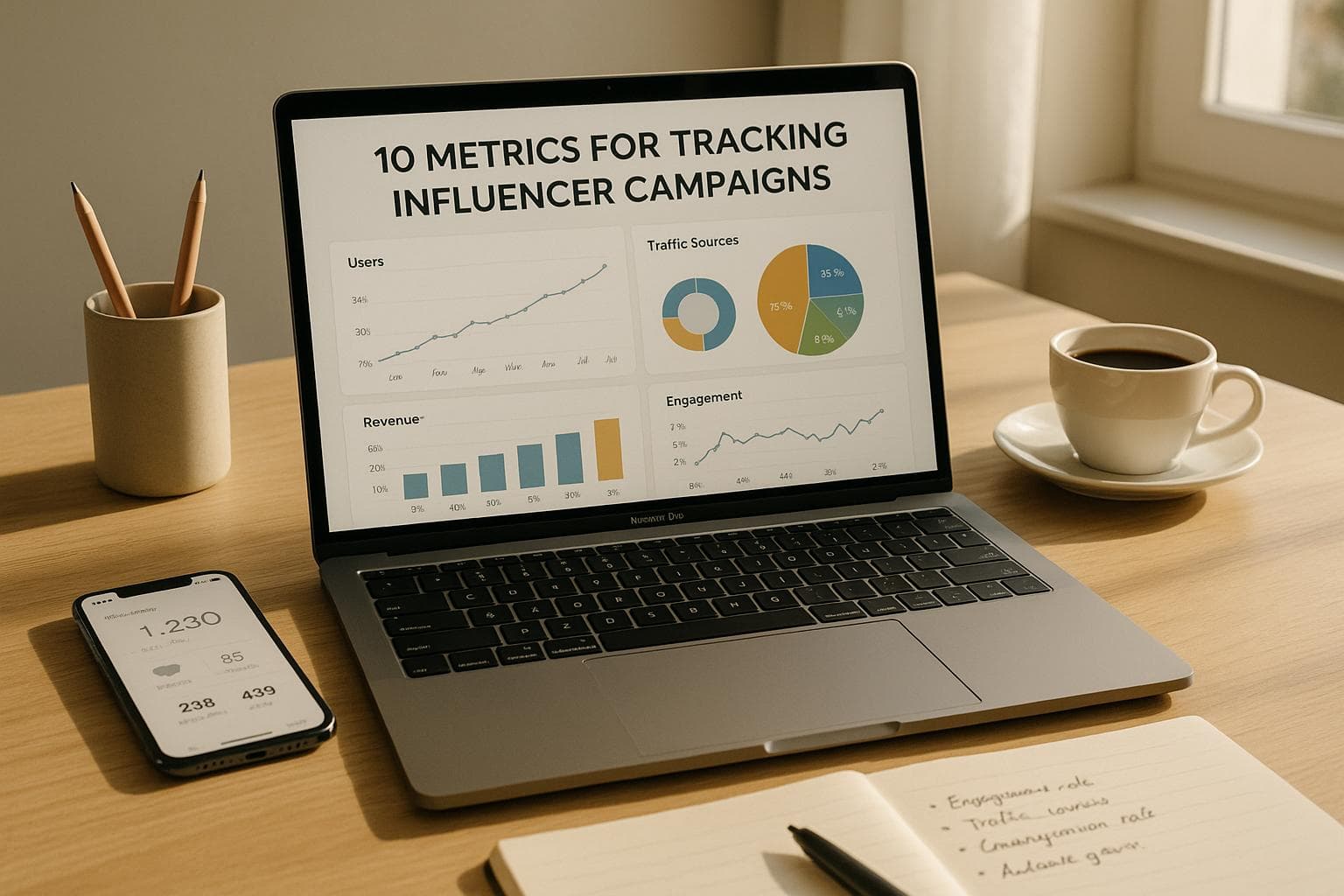5 Steps To Score Influencer-Brand Fit
Learn a structured approach to find the right influencers for your brand, aligning goals, audience, and identity for successful partnerships.

Matching the right influencer to your brand doesn't have to be overwhelming. Here's a simple 5-step framework to help you find influencers who align with your goals, audience, and brand identity:
- Set Clear Goals: Define your campaign's main objective (awareness, sales, leads, or community) and identify your target audience's demographics, online behavior, and values.
- Check Influencer Quality: Evaluate their content, engagement, follower authenticity, and past brand collaborations.
- Measure Past Results: Analyze engagement rates, sales impact, and platform performance metrics.
- Match Brand Identity: Ensure their tone, visuals, and audience align with your brand's style and values.
- Test and Track Results: Start with a small campaign, monitor performance metrics, and adjust based on data.
Pro Tip: Use tools like Influs to simplify influencer analysis and track campaign success. This structured approach ensures better partnerships and measurable outcomes.
How to choose influencers for long-term brand partnerships
Step 1: Set Clear Goals and Know Your Audience
Before diving into influencer selection, make sure you’ve outlined your objectives and understand your audience.
Define Campaign Goals
Your campaign goals will shape your influencer strategy. Focus on measurable objectives that can deliver both immediate results and long-term benefits:
- Primary Goal: Pick one key focus for your campaign, such as:
- Increasing brand awareness (e.g., reach and impressions)
- Generating leads (e.g., email signups, downloads)
- Driving sales (e.g., direct purchases)
- Building a community (e.g., gaining followers, boosting engagement)
- Metrics for Success: Decide how you’ll measure progress:
- Engagement rates
- Click-through rates
- Conversion numbers
- Return on investment (ROI)
- Timeline and Budget: Set clear deadlines, allocate budgets for each influencer, and determine your overall spending limits.
Understand Your Target Audience
Get specific about who you’re trying to reach. Break it down into these categories:
Demographics
- Age, gender, and location
- Language preferences
- Job roles and income levels
- Education and personal interests
Online Behavior
- Social platforms they use most
- Times they’re active online
- Types of content they engage with
- Shopping habits
Values and Interests
- Brands they already support
- Lifestyle and hobbies
- Causes they care about
- Entertainment choices
Using tools like Influs can help verify audience data, ensuring your campaign aligns with real follower insights. Once your goals and audience are clearly defined, you’ll be ready to evaluate influencers effectively in the next step.
Step 2: Check Influencer Quality
Now that you've outlined your campaign goals and identified your audience, it's time to evaluate potential influencers to ensure they're a good fit for your brand.
Review Their Content
Take a close look at the influencer's content across their social media platforms. Pay attention to:
- How consistent their visuals are and whether they align with your brand image
- How often they post and stay active
- The overall quality of their photos, videos, and other content
- Their writing style and tone - does it match your brand voice?
- How engaged their followers are in the comments and interactions
Evaluate Follower Authenticity
Use tools like Influs analytics to dig deeper into their follower base. This includes:
- Checking for genuine engagement patterns
- Identifying and filtering out fake or inactive followers
- Confirming their follower demographics match your target audience
- Analyzing follower growth trends for any unusual spikes
Watch out for warning signs like sudden jumps in followers, inconsistent engagement rates, spammy comments, or signs of bots.
Research Their Background
Do some homework to protect your brand's reputation. Focus on:
- Their track record with past partnerships and campaign reliability
- Any public statements or past content that could reflect poorly on your brand
- Compliance with social platform rules
- How well they've worked with other brands in the past
Influs's influencer reports can provide detailed insights into their performance metrics and collaboration history, helping you make well-informed decisions.
sbb-itb-0e1095d
Step 3: Measure Past Results
Once you've ensured quality, it's time to evaluate how things have performed. Focus on engagement, the impact on sales, and how well your efforts worked across different platforms.
Track Engagement Metrics
Here’s what to look at:
- Engagement rates: Compare your average rates to industry standards.
- Comment quality: Are the comments relevant and meaningful?
- Shares and saves: These indicate how much your content resonates with the audience.
- Story completion rates: High completion rates suggest viewers are staying engaged.
Assess Sales Impact
After checking engagement, dive into sales-related metrics:
- Conversion tracking: Keep an eye on click-through rates (CTR) and sales from sponsored posts.
- Attribution tools: Use integrations like Shopify to directly connect sales to specific campaigns.
- Profitability metrics: Calculate cost per acquisition (CPA) and return on ad spend (ROAS) to see if your efforts are paying off.
Compare Social Platform Performance
Analyze how each platform is performing:
- Engagement and growth: Check follower growth, engagement levels, and how well content performs on each platform.
- Content formats: Identify which types of content work best on each channel.
- Audience alignment: Make sure the platforms align with your target audience’s preferences.
Using cross-platform analytics can help you spot trends and find out where your strategy works best.
Step 4: Match Brand Identity
Make sure the influencer’s style, values, and audience align with your brand’s personality and goals.
Compare Message Style
Take a close look at how influencers communicate:
- Tone and voice: Does their content match your brand’s vibe? For example, a luxury brand might need a polished, sophisticated tone, while a brand targeting younger audiences might prefer a fun, casual style.
- Visual aesthetics: Check their photos, color schemes, and overall production quality. These should complement your brand’s look and feel.
- Values alignment: Ensure their stance on key social issues aligns with your company’s principles.
When their style matches your brand, it strengthens your overall message.
Study Past Brand Work
Look into the influencer’s history with other brands:
| Aspect to Review | What to Look For |
|---|---|
| Brand Types | Categories and industries they've collaborated with |
| Content Quality | Whether their sponsored posts feel genuine |
| Disclosure Practices | Proper and transparent sponsorship disclosures |
| Engagement Patterns | How their audience reacts to branded content |
Pay attention to potential conflicts with other brands they’ve worked with, their ability to maintain long-term partnerships, and whether their sponsored content feels genuine and relatable.
Check Audience Match
Ensure their audience aligns with your target market by examining:
- Demographics: Do their followers match your customer base in terms of age, gender, or other key factors?
- Interest overlap: Are their audience’s interests similar to your brand’s focus?
- Geographic distribution: Does their follower base include people in your target regions?
- Purchase behavior: Does their audience’s buying habits align with your product category?
Consider using tools like Influs to confirm audience compatibility. Once you’ve matched their identity to your brand, you’re ready to move forward with testing influencer partnerships.
Step 5: Test and Track Results
Carefully test your influencer choices before committing to a larger campaign.
Start Small
Begin with a limited test campaign to evaluate performance:
- Focus on a single post instead of a full campaign.
- Set clear performance indicators to measure success.
- Run the test for 2-4 weeks.
- Keep the initial budget low to reduce risk.
- Conduct A/B tests to determine which content works best.
Monitor Progress
Keep an eye on key metrics during the test campaign:
| Metric Category | Key Measurements |
|---|---|
| Engagement | Likes, comments, shares, saves |
| Reach | Views, impressions, unique viewers |
| Conversions | Click-through rate, sales, sign-ups |
| Brand Impact | Audience sentiment and hashtag usage |
These metrics can help you make quick adjustments. Tools like Influs's reporting can show which content formats and messages resonate most with your audience.
Learn and Adjust
Use the data from your test campaign to refine your strategy:
- Review Performance
- Compare results to your initial goals.
- Analyze audience feedback.
- Identify the content that performed the best.
- Improve Strategy
- Note which messaging styles worked well.
- Determine the best times and formats for posting.
- Adjust your performance benchmarks.
- Refine your targeting approach.
If the test delivers good results, consider scaling up the partnership while continuing to monitor performance. If the results are lackluster, use the insights to improve future influencer selections and campaigns. Keep refining your process to ensure better outcomes over time.
Conclusion
Finding the right match between influencers and brands requires a structured, data-focused approach. Following the steps outlined earlier, a final review can simplify the process by focusing on these key aspects:
- Define clear campaign goals and understand the demographics of your target audience.
- Check influencer quality by reviewing their content and ensuring their followers are genuine.
- Examine past performance metrics, including engagement rates and sales impact.
- Assess brand alignment, ensuring their messaging and audience are a good fit for your brand.
- Start small, testing partnerships with limited campaigns before committing to larger collaborations.
Tools like Influs's real-time analytics can help brands:
- Verify influencer credibility.
- Examine audience demographics and engagement levels.
- Track campaign performance effectively.
- Use data to refine strategies and improve results.
Building strong influencer-brand partnerships is an ongoing effort that demands regular monitoring and adjustments. By starting with thorough research, testing carefully, and using performance data to guide your strategy, you can create collaborations that connect with your audience and deliver measurable business outcomes.
Related posts
- Guide to Instagram Analytics for Influencer Selection
- Best Practices for Influencer Contract Agreements
- 8 Common Influencer Marketing Mistakes to Avoid
- Ultimate Guide to Post-Campaign Feedback Analysis
Related Posts
Continue reading with these related articles


